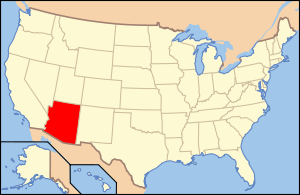Viticulture in Arizona
| Arizona | |
|---|---|

|
|
| Official name: | State of Arizona |
| Appellation type: | State |
| Year of establishment: | 1912 |
| Viticulture tradition since: | 16th century |
| Country: | United States |
| Sub-regions: | Sonoita AVA |
| Recognized cultivation area: | 295,254 km² (113,998 sq mi ) |
| Grape varieties: | Cabernet Franc , Cabernet Sauvignon , Chardonnay , Concord , Counoise , Gewürztraminer , Grenache , Malvasia , Merlot , Mourvèdre , Muscat Canelli , Nebbiolo , Petit Verdot , Petite Sirah , Pinot Gris , Pinot Noir , Riesling , Sangiovese , Sauvignon Blanc , Syrah , Viognier , Zinfandel |
| Number of wineries: | 20th |
Viticulture in Arizona refers to viticulture in the American state of Arizona . Under US law, every state and county is by definition a protected designation of origin and does not need to be recognized as such by the Bureau of Alcohol, Tobacco, Firearms and Explosives .
history
European missionaries first came to the area in the 16th century: Marcos de Niza , a Spanish Franciscan , traveled what is now the southwestern United States around 1539 and described the Seven Golden Cities of Cibola. Francisco Vásquez de Coronado , a Spanish conquistador , sought these cities in the area from 1540–1542. The actual colonization began by Catholic- Spanish missionaries. They began to convert the Indians to the Catholic faith. In order to have the necessary mass wine , the missionaries planted the first vineyards in Arizona.
location
Much of the vineyards are in the southeastern part of the state near the metropolitan area of Tucson . There, with the American Viticultural Area Sonoita AVA, is the only specific defined designation of origin. In recent years, successful wines have been created from the Italian grape varieties Nebbiolo and Sangiovese as well as from the typical Rhône wine varieties Mourvèdre, Durif, Syrah and Viognier .
See also
literature
- André Dominé (Ed.): Wine . Tandem Verlag, Königswinter 2007, ISBN 978-3-8331-4344-1 .
- Bruce Cass, Jancis Robinson : The Oxford Companion to the Wine of North America . Oxford University Press, Oxford et al. 2000, ISBN 0-19-860114-X .
Individual evidence
- ↑ a b Appellation America (2007). "Arizona: Appellation Description" . Last page view on October 20, 2008.